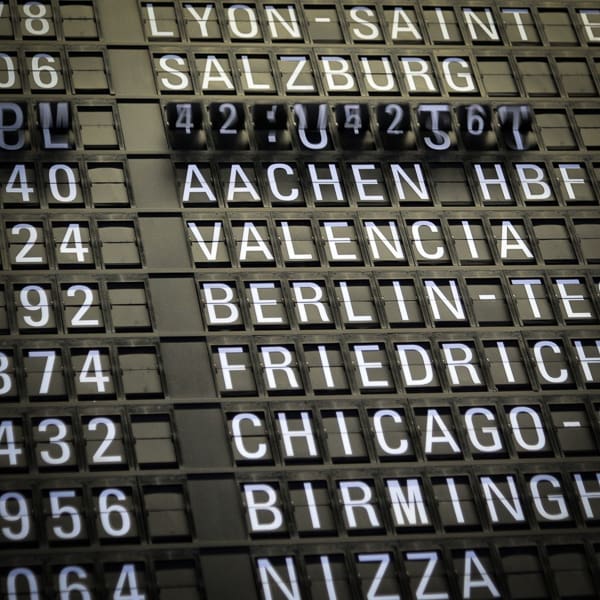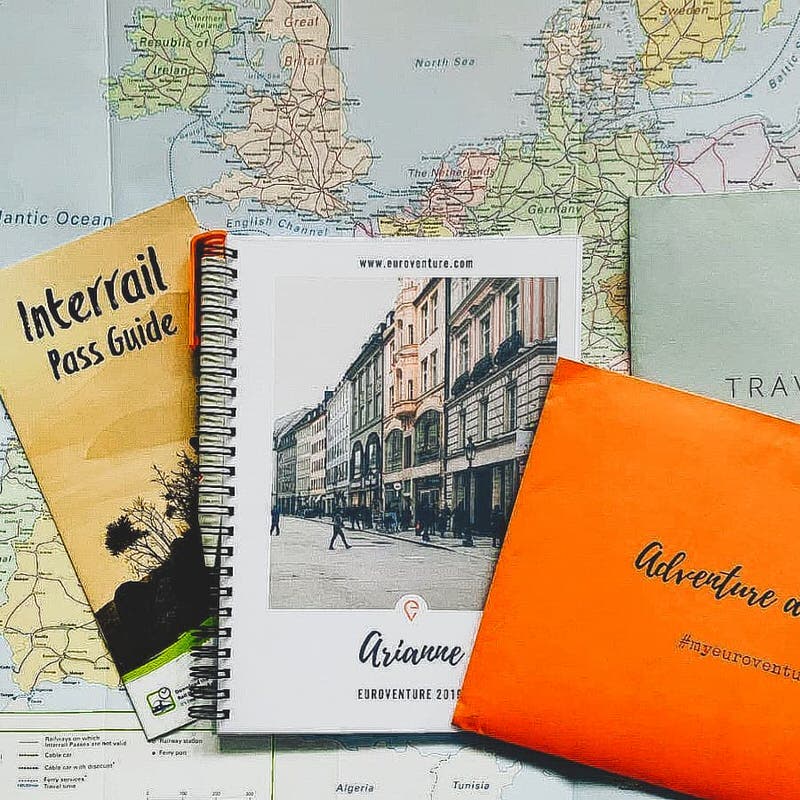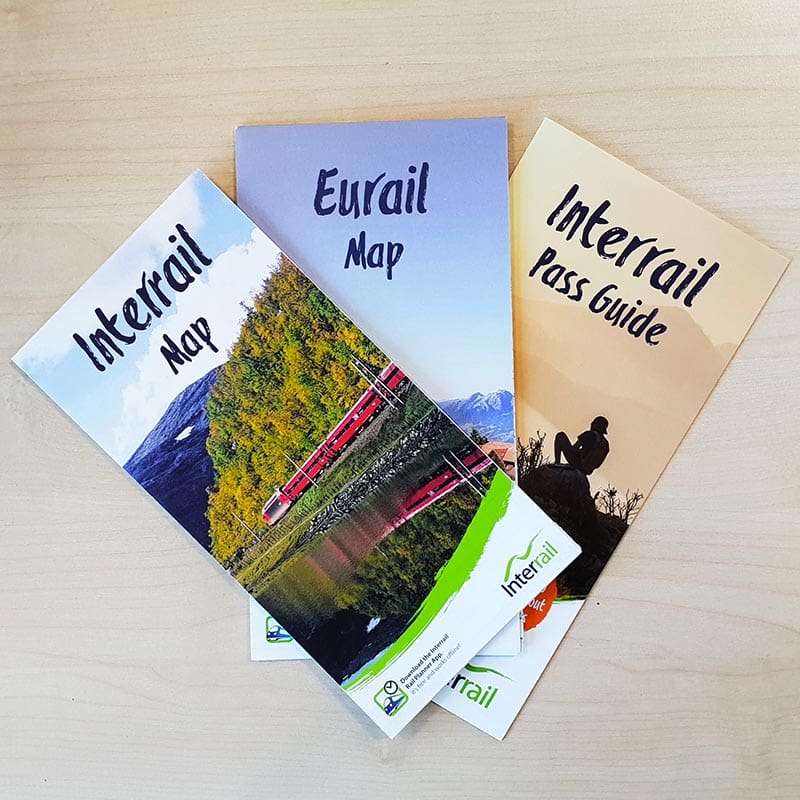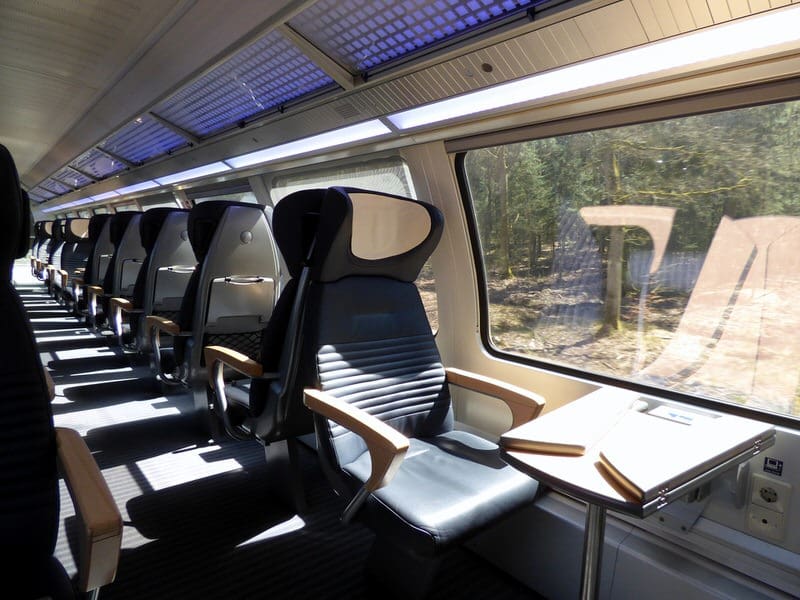Traveling by Train in Europe: Where, Why, and How
What is the train service to travel around europe
If you haven’t read our Ultimate Guide to Travelling Europe, here’s the short version…
Travelling Europe by train is easy, comfortable, scenic and efficient. Compared to flights your journeys will be easier and more comfortable – plus there’s far less risk of being caught with extra charges for luggage or checking in! Most parts of Europe have excellent high-speed networks, and even on slower routes you’ll still get amazing views and more space to stretch your legs. Overland travel gives you a great chance to see the landscape change in front of your eyes – from mountains to coastal vistas and rolling countryside. Bring a picnic, or head to the buffet carriage to enjoy lunch with a view. If you fancy a touch of luxury, you can upgrade to first class to make the experience extra special.
Once you arrive, you’ll generally find yourself right in the heart of the city, making it easy to get to your accommodation quickly. No messing about with baggage reclaim or taxis required!
There are loads of different way to sort out your travels in Europe, and if you don’t want to deal with organising all the tickets, Eurail/Interrail passes, seat reservations, supplements and more, then let us do the work for you.
Interrail vs. Eurail
What is Interrail/Eurail?
Interrail and Eurail passes are two types of European rail pass, used for travelling Europe by train.
Both types of pass are very similar in usage – your nationality or residence decides which sort of pass you need.
Each pass allows you to travel within and between European countries by train. The passes are valid for a set number of travel days within a usage period.
Should I buy an Interrail or a Eurail pass?
You are eligible for an Interrail pass if you’re:
1. A European citizen (or if you have dual citizenship) and you hold a European passport.
2. A non-European citizen who has lived in a European country for at least 6 months.
You need a Eurail pass if neither of these rules applies to you.


What kind of Interrail/Eurail passes are there?
Both Interrail and Eurail passes come in different types, and are available for people of all ages (so not just students!).
There is a reduction in price for under 28s and for over 60s – so make sure you let us know the correct age group, or your pass won’t be valid. Don’t think you can pay less by “looking young” – unfortunately, your passport number and date of birth will be printed on the ticket – so you probably won’t get away with it!
One country vs. global passes:
Interrail and Eurail passes come in a variety of different prices, and you can buy either a “Single Country” or a “Global” pass. For the global pass, you’ll also need to choose how long you want to use the pass for:
- You can buy a Single Country pass which is always valid for 1 month, but only within one country (or a selection of countries in the case of the Benelux pass).
- Or, you can buy a “Global” pass which is valid across the whole of Europe (or, at least most of it). You can choose how long you want to use them for: from 5 days up to 60 days! Each option has a different price.
As well as choosing how long you want the pass to be valid for, there is an option to select how many “travel days” you want. Don’t worry, we take all of this into account for every package, so you don’t have to work it out yourself!
What is an Interrail travel day?
An Interrail “Travel day” is a day when you will be using your pass to travel by train from one of your destinations to the next. There is no limit on the number of trains you can get within the 24 hour period from midnight.
Within the usage period (of up to 2 months) you will be asked how many “travel days” you want to have.
For interrail the options (from cheapest to most expensive) are:
- 5 travel days within a period of 1 month
- 7 travel days within a period of 1 month
- 10 travel days within a period of 2 months
- 15 travel days within a period of 2 months
- Travel every day within a period of 22 days
- Travel every day within a period of 1 or 2 months
For Eurail the number of days are slightly different, but the principle is the same. Already got your Interrail or Eurail pass and not sure how to use it? Check out our step by step guide on how to use your Interrail/Eurail pass.


How do I know what kind of Interrail/Eurail pass I need?
For most people, the best way to work out what kind of pass you need is to first work out your route and then plan how long you’ll be travelling Europe by train. Next, work out how many travel days you will be taking. Then you need to work out which journeys will require additional seat reservations, and work out how much it will cost to buy those on top.
Unfortunately, the addition of Interrail reservations can make choosing your pass quite confusing. Sometimes the high cost of certain interrail reservations means that it makes more sense to choose a cheaper pass and buy a few extra tickets at full price, but then you’re into all sorts of comparisons and calculations…
So where do you start. Luckily when you book with us, we work out exactly which tickets, passes and reservations you’ll need and which combination works out the cheapest.
Let’s talk more about these pesky reservations…
Seat Reservations
What is an Interrail/Eurail seat reservation?
Interrail or Eurail seat reservations are extra bookings required on certain trains when travelling Europe using an Interrail or Eurail pass. They are not tickets, but are used together with your rail pass to allow you onto certain services.
As well as being compulsory to board certain services, they also guarantee you a seat on the train that you’ve selected. That can be a bonus in peak season when trains get really busy!
Once you’ve purchased a reservation, you’ll need to stick to the train time you’ve selected, as the reservation is only valid for that departure.
Do I have to buy an Interrail reservation?
If you’re using a rail pass and the route you’re taking has a “reservation required” symbol on it, unfortunately, you must buy one. If you do not present a reservation with your pass when your ticket is checked, you’ll be asked to either leave the train at the next stop or pay a fine of up to €200. Nobody wants that, so make sure you do your research before you go!

How do I know when I need one?
Good question, and unfortunately that can be tricky. The rules change regularly and the information is not always easy to find. As a general rule, you will need one on any high-speed train in Western Europe, and on any sleeper train.
On local and regional trains it’s usually not necessary to have a reservation. For our full guide on this, head to our Interrail reservations guide. When you book with us, we’ll buy you all the passes, tickets and reservations you need, tell you which ones to use and when, and let you know where you can travel without any. Easy!
If you want to check requirements, the best app for train travel in Europe is DB Navigator. This gives you pretty up to date information about all European services as far as possible.
How much does an Interrail/Eurail Reservation cost?
The cost varies depending on each country’s rail services but generally falls between 5 euros and 30 euros.
If you’re looking to save money and you aren’t short of time, it might be worth seeking out slower journeys so that you can avoid paying for reservations on certain routes – plus, you might get an awesome view!
When we book trips for our customers, we work out the most cost and time efficient way to do each journey. Using our comparison software, we find the best possible combination of full fare tickets, rail passes and reservations. This means we can work out the best possible cost. That means we reduce the cost for you guys, while booking the journeys that make the most sense for your trip. Create your dream route here with our interactive map planner.
Is First Class worth it?
First class versus second class train travel in Europe:
Usually, trains in Europe have two class options – 1st and 2nd. On high-speed trains in Spain and Italy you may also find more options to suit various budgets and comfort levels. First class train travel in Europe usually costs significantly more than second class – first class tickets could be 3 or 4 times the price when bought on the day. You can also choose a first-class rail pass and first class reservations if you go for an Interrail or Eurail pass. These cost around twice the price of their second class siblings, but you also pay more for seat reservations.
The differences between first and second class trains are most noticeable in Western Europe – France, Switzerland, Germany, Netherlands, Spain and Italy all have pretty luxurious first class options. For train travel through Eastern Europe, there’s less of a difference as services are slower and trains older as a general rule. Here it might well not make a lot of difference whether you upgrade or not.


If you’re not sure whether this is something you might want to splurge on, check out the major differences in service level below:
- Second class trains provide basic but comfortable facilities, with drinks and snacks available to purchase. Some high-speed trains will offer free entertainment or wifi.
- You can always reserve a seat, whether you’re in first or second class.
- First class trains will provide more spacious seats with more leg room than second class.
- First class carriages will generally be quieter with fewer passengers.
- On major high-speed routes, first class may well offer additional perks, such as free drinks/snacks, free WIFI and complimentary newspapers.
- On regional routes, there are unlikely to be any additional benefits beyond more space. For these trains, it may not be worth paying the extra.
Overnight train travel
Overnight transport can be a great way to maximise your time when travelling Europe by train. All night trains will require an extra supplement to be paid, on top of your Interrail or Eurail pass.
As we’ve mentioned in our video guide, here are a range of different options for overnight travel. You can choose based on your preferred comfort level and budget between the following:
- Seat – the cheapest option, you’ll have a seat in a normal carriage, which reclines back a little bit.
- Couchette – you’ll share a cabin with other travellers. Couchettes are normally for 6 people and offer a small bed with sheet and blanket for you to use. A more comfortable option than a seat, but cheaper than a sleeper.
- Sleeper – depending on your group number, you’ll share your cabin with other travellers. Sleeper compartments are for up to 3 people, with a comfy bed, duvet, sink and space for hanging clothes. Often refreshments and breakfast are included.
- Private sleeper – the same as a sleeper, but you book out the whole cabin for yourself and/or your group. This is the most expensive option, offering the highest level of comfort.

How much does a night train supplement cost?
The costs vary a huge amount; a seat or couchette could start from as little as 10-30 euros. A private sleeper could set you back over 200 euros!
Some overnight trains – such as the night train from Venice to Paris – don’t offer Interrail reservations. Instead they just offer you a discount of around 25% off full price tickets with your pass. These might be best avoided if you’re looking to save money.
Advance Tickets
After all this talk of Interrail and Eurail passes, it’s easy to forget that these passes aren’t the only way to travel Europe by rail! In many cases rail passes provide great value, but not always. If your journey is short or will involve a lot of costly reservations, it might actually be cheaper to buy your tickets individually.
Advance tickets can be even cheaper than a pass – particularly if you check different booking sites for deals. The only down-side is that booking in advance means losing some flexibility. For the cheapest fares, you generally have to stick to the chosen service. If you miss it, you will be asked to buy a new ticket!
We’d advise booking as early as you can manage – at least 3 months is best in most cases. This will give you the greatest choice of times at the best prices. Different providers have different bookings horizons, so you’ll need to keep your eye on the ball to keep track of availability. You can use the handy DB Navigator app to reliably check which times are available across most providers.
It’s also worth noting that a large percentage of European train tickets are not available as E-tickets. Remember that you’ll need to factor in P&P processing time and costs – or use a local agent in your home country.
We will consider all these factors for you when you book with us, so you can rest assured that as the experts we will take all of this into account!
Traveling by Train in Europe: Where, Why, and How
:max_bytes(150000):strip_icc()/GettyImages-1023715348-1369f4cf9fcf4c7c839c2d35ab84bc5f.jpg)
Train travel has been the transportation method of choice in Europe for many years for good reason: Europe is dense enough that train travel is efficient, taking you from city center to city center much quicker than you can when flying.
Buying Train Tickets and Rail Passes
The easiest place to buy your train tickets in Europe is at Rail Europe. They also sell rail passes, which are convenient if you plan on making lots of journeys.
Top International High-Speed Train Routes
Europe has an extensive high-speed rail network, connecting cities such as Paris, Barcelona, and London quickly and easily.
The main two international services are the Eurostar (connecting London with mainland Europe) and the Thalys, which connects Paris to Belgium, Holland and north-west Germany, with Brussels as the main hub.
Within the Schengen Zone, Europe’s border-free zone, you can board a train in one country and end up in the other without even realizing it. Though Britain isn’t in the Schengen Zone, border controls for Eurostar routes to and from London are conducted by both countries before you depart, which means you can just jump off the train and walk out the station at the end of your journey without standing in any lines.
Check out some of the best international routes in Europe:
- London to Paris 2h30m
- London to Brussels 2h
- Paris to Brussels 1h20m
- Paris to Barcelona 6h30
- Frankfurt to Paris 3h50m
- Hamburg to Copenhagen 3h55m
- Frankfurt to Zurich 4h
Of course, you’re actually more likely to be taking trains within a single country. Read on for country-specific advice for train travel in Europe.
Spain
Spain has more kilometers of high-speed rail tracks than anywhere else in Europe (and is second worldwide, after China). All the routes go via Madrid, which means you’ll probably need to change there to get from north to south, although there are some continuous routes that cross the entire country.
- Madrid to Barcelona 2h30m
- Madrid to Seville 2h30
- Barcelona to Seville 5h15m
- Madrid to Malaga 2h20
Germany
Germany started the high-speed train movement in Europe, but the roll-out stagnated for some years, which means that key routes (such as Berlin to Munich) don’t yet exist. (You can still take the train from Berlin to Munich, but it’s not really any quicker than the bus.
High-speed trains in Germany are called ICE.
- Berlin to Hamburg 1h55m
- Frankfurt to Cologne 1h20m
- Frankfurt to Munich 3h10m
Italy
The high-speed rail network in Italy is essentially one long line that connects Naples to Turin, via Rome, Florence, Bologna, and Milan.
- Rome to Florence 1h20m
- Rome to Milan 2h55m
- Rome to Bologna 1h55m
- Rome to Naples 1h45m to Turin 4h05m
- Milan to Bologna 1h
- Milan to Turin 45m
France
There are not many high-speed rail routes in France, though the network is expected to roll out further in the next few years, eventually connecting Paris to Bordeaux.
- Paris to Lyon 1h55
- Paris to Marseille 31h15
- Paris to Strasbourg 1h45
- Paris to Lille 1h
Train Travel vs. Flying
How do these travel times compare to flying? Let’s consider a one-hour flight. We’ll add a half hour to get to the airport via taxi or rail connection (remember to add the costs!) They’ll want you to be there well in advance of take-off, let’s say an hour minimum. You’ve already doubled the travel time, and you’re not even close to your destination.
Then consider that it takes a half hour to get your bags and get to the front of the airport to survey the options to get you into town. Choosing a taxi, you might be lucky to get to the city center and your hotel in a half hour. Add another hour in total to your travel time.
So now we’re at 3.5 hours for a “one-hour” flight.
Another thing to consider is that budget airlines often operate out of Europe’s smaller airports. You’ll have to consider this when you want to take a budget flight to connect your international flight to your final destination. For example, most international flights arrive at London’s Heathrow airport, but budget airlines tend to fly out of London Stansted, London Gatwick or London Luton airports.
Some airports are notoriously far from the city they claim to serve. Ryanair calls Girona in Spain ‘Barcelona-Girona’, even though it is 100km from Barcelona, while Frankfurt-Hahn Airport is 120km from Frankfurt itself!
Prices for budget airlines and high-speed rail connections are often similar, though flights are often cheaper when booked well in advance and more expensive at the last minute.
Train Travel vs. Driving
High-speed train travel is invariably quicker than driving. It will also usually be cheaper when traveling alone or in a pair. Remember that toll roads are very common in Europe, which will push up the price of your journey considerably. Only when you fill a car can you be more confident of savings.
Here are some other pros and cons of driving as compared to taking the train.
How To Travel Europe — By Bus, Train, Car & More

Whether it’s hopping by sleeper train through Central Europe, road tripping through Eastern Europe, or catching budget flights for many a Mediterranean holiday, I’ve used every method to travel Europe.
Here, I’ll share by best tips for getting around Europe cheaply and easily!
The best way to travel around Europe
Each mode of travel in Europe has its own pros and cons. But Europe is especially great to travel by public transport.
I’m Dutch and I’ve always loved traveling Europe by train or bus. But I noticed American friends are sometimes surprised at how good the services are in Europe when they first use it.
If you’re from the US, forget about syrupy slow Amtrak trains or sketchy Greyhound buses, as European services are of much greater quality and network density.
There is also a wealth of budget airlines servicing all corners of the continent, sometimes flying you for peanuts. Air travel isn’t the best for the environment, but it can be fast and cheap.
Tip: Not sure how to get from A to B? Just use Rome2Rio to get estimates for trains, buses, flights, rideshares, and driving.
Travel Europe by train
I just love traveling Europe by train. It’s comfortable, you can watch the landscapes pass you by, there is little to no security hassle to deal with, the trains often arrive right at the heart of a city, and they give you more leg-space compared to buses or planes.
(It’s also 10x to 20x better for the environment than flying!)
If you have any romantic notions around train travel then you’ll surely love taking trains in Europe.
Trains are especially good in Scandinavia, Western Europe, and Central Europe. But trains can be quite poor (or nonexistent) in Eastern Europe and the Balkans.

Taking domestic trains
If you just need to use a local or regional train within a country, you can just get tickets from the local railway company. Sometimes it can be a good idea to book ahead your journey a day or two in advance (especially for busy holidays like Easter), but typically you can also just show up at the station and get your ticket there.
On these trains, there are usually no assigned seats and prices are fixed.
Taking long-distance trains
It’s a different story with high-speed trains (such as France’s TGV, Germany’s ICE, or Spain’s AVE), overnight trains, or long-distance international trains.
These do require a seat reservation or at least a ticket for the specific day. They also often have variable pricing, so booking early could save you money.
Sadly, the European rail system is still a crazy patchwork of different rail companies, ticketing systems, and languages. Some trains still need printed tickets, others just an e-ticket with a QR code. If you travel through many countries in Europe it can be frustrating having to figure this stuff out every time.
Luckily, some sites have made it easier in recent years. I highly recommend using RailEurope.com (formerly known as Loco2) where you can book trains from pretty much any rail company. After booking you also get clear instructions in English on how to use your tickets.
Unlimited train travel with Eurail
If you’re planning a big backpacking trip through Europe, you may want to consider getting an Eurail pass. (Note: Eurail pass is for non-Europeans. The Interrail Pass is for European citizens.)
Eurail is a global pass that you pay once and can then use for unlimited travel within the number of days you’ve purchased. For example, the most popular EUrail pass gives you 10 travel days within 2 months — and during those 10 days, you can have unlimited travel on trains.
The time limit only starts when you start using the pass. You may still need to reserve seats on some train journeys, especially when using high-speed rail. 31 countries are included in the pass.
These passes will give you the best deal if you’re under 28 years old. For example, you can get 10 days of unlimited 2nd class travel within 2 months for just $542. Or you can get 5 days of unlimited 2nd class travel within 1 month for $363. These prices go up if you’re older.
If you plan to use trains a lot and if you’ll travel long distances within Europe, I think these passes are great. If you’ll be covering lots of ground it will probably cost less than buying individual tickets.
But if you plan to make smaller hops between cities (and so you’re not using your ‘unlimited travel’ days to the maximum) or you want to use rail for only some of your travels, then an Eurail pass might make less sense for you. Try doing the math and see if it will actually save you money.
Travel Europe by bus
Low-cost bus companies let you hop around Europe with ease. Short domestic bus services can be booked locally, but for long-distance and international buses it’s best to book them online.
Tip: Use Omio.com for booking buses in Europe. Be sure to always click ‘Show more results from affiliates’ to see cheaper services like Flixbus that are normally hidden.
For international bus connections, Eurolines has the biggest network. These days, they also face stiff competition from low-cost services like Megabus and Flixbus.
Buses are a great way to get around everywhere, but especially in Eastern Europe where the rail infrastructure isn’t as good.

If you’re on a budget, you should definitely try Flixbus. It mainly has routes going through Germany and Central- and Eastern Europe though its network is rapidly expanding.
Flixbus can be crazy cheap, especially if you book early, as it operates on a model similar to budget airlines like RyanAir. Flixbus works as a franchise so the type and quality of the buses vary a lot, though I’ve been fully satisfied with the Flixbuses I’ve been on. Just don’t expect the Free Wi-Fi that’s advertised to work, or actually exist.
I recently took a Flixbus between Lisbon and Seville for just €10, which is normally around €45 with other bus companies. That beats even the cheapest airlines.
Before writing this today I even saw Flixbus tickets on this same route for just €1! Granted, that was a 5.40 am bus that had to be booked a week ahead, but if you’re traveling on a shoestring you’ll surely want to keep your eyes peeled for such amazing sales.
Travel Europe by car
Traveling around Europe by car is a great idea, too. If you already have your own car, then you’re all set!
If you want to rent a car, then there are a few things to know:
- Make sure you can drive manual as most cars in Europe are
- Not a European Union citizen? Then you’ll probably need an International Driving Permit
- Rental cars are usually quoted without insurance, but it’s a legal requirement to always have third-party liability insurance. Add it during the reservation process or ensure you have your own
- It’s usually fine to cross borders between European Union member states, but going outside the EU (with a car rented within the EU) may be disallowed or incur extra fees
Rentalcars.com is a pretty good site to look for — wait for it — rental cars. After searching there, you can still check the companies and book with them directly, as this will cut out an unnecessary middleman. In Europe you’ll find all the usual car rental companies like Avis, Hertz, Thrifty, etc. as well as Europcar.
Personally, I like to travel around Europe mainly by bus, train, or plane, but sometimes I’ll get a rental car in location or for a mini-road trip for a week.
Another option is long-distance ride-sharing. The biggest platform for this in Europe by far is Blablacar.com.
It works vaguely like hitching between cities, except all the drivers have verified profiles and you pay them for their services. You can rate your profile from ‘bla‘ up to ‘bla-bla-bla‘ depending on how much you typically like to chat during a journey. I’ve had some mixed experiences with Blablacar, but on certain routes it can be a convenient and affordable option.
Travel Europe by camper van
Traveling by camper van will give you a whole different feel for Europe, as you’re able to stop in scenic nature locations and go far beyond the usual city-hopping itineraries.
To do this properly you could buy or renovate a van yourself, just as my dad did in the ’80s when he modded a vintage Type H Citroen and drove it from campsite to campsite through the Alps. (I really need to do something like it one day!)
But if you want to get just a little taste of the #VanLife, you can also easily rent a campervan for a European road trip.

Europe’s largest provider of travel vans is Indiecampers. They were founded in Lisbon (where I live now), so I see their vans going up and down the Portuguese coast all the time, though they are currently based in dozens of locations all over Europe. They have a fleet of Millenial-friendly high-top campervans.
You can drive the vans all around the European Union, plus Iceland, Norway and Switzerland. The costs depend hugely on location and season, ranging from €39 per day in the winter off-season in Spain to about €169 per day during August in Germany.
Travel Europe by plane
If you want to hop around Europe quickly and cheaply, then planes can make that happen. Numerous budget airlines cross the skies in Europe, including easyJet, Wizz Air, Eurowings, Vueling, Level, and — the biggest and arguably most notorious of them all — RyanAir.
The base price for these flights can be very low, but keep in mind these airlines will ding you for anything extra. You’ll have to pay to add checked-in luggage, for drinks or snacks on the flight, for seat selection, and many other things. The restrictions for carry-on luggage also differ per airline, with RyanAir being particularly stringent.
Sometimes I’ve found that a ticket with RyanAir is just barely cheaper than one with a full-service airline, at least once you start adding all the extra costs. Still, if you can limit your luggage to carry-on size, you can fly around Europe rather cheaply and easily.
I have many expert tips for booking flights. But generally, try researching flights using Kiwi.com, which I think is the most powerful search engine, but then book the tickets directly with the carrier. Avoid booking with sites like Gotogate, Travel2be, or eDreams (often linked by flight search engines) as they have poor customer service or terrible refund policies.
Consider the impact on the environment of flying, especially for shorter distances. You can also choose to offset the carbon emissions of your flight.
Some links may be affiliate links, meaning I may earn commission from products or services I recommend. For more, see site policies.
Source https://www.euroventure.com/planning/travelling-europe-by-train-need-to-know/
Source https://www.tripsavvy.com/traveling-by-train-in-europe-4079758
Source https://www.indietraveller.co/how-to-get-around-in-europe/